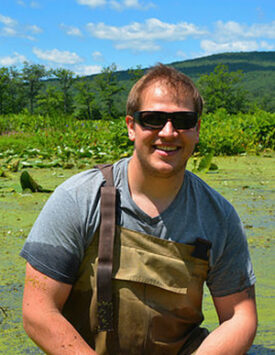Devin earned a B.S. in biology with minors in chemistry and history from the University of Pittsburgh (Oakland) in 2008. His interests in ecology were realized after working as an undergraduate assistant with Dr. Rick Relyea, where he worked with numerous aquatic species, including invertebrate predators, amphipods, snails, and tadpoles, and learned about ecological topics, such as phenotypic plasticity, eco-toxicology, and sexual selection among others.
During his time in the Relyea lab, Devin earned an NSF fellowship (Research Experience for Undergraduates Fellowship) which funded three experiments. Two of the experiments focused on the impact of Roundup Original MAX© herbicide on tadpole growth and survival, while the other was testing the lethality of Roundup Original MAX© on larval amphibians. His time spent as a laboratory technician was devoted to examining the lethal effects of the insecticide endosulfan to larval amphibians using lethal concentration tests.
While working on a Masters degree in the Hopkins Lab, Devin studied the effects of maternal transfer of mercury in snapping turtles (Chelydra serpentina) and its effect on hatching success among offspring. Due to their carnivorous diet, snapping turtles have the potential to accrue levels of mercury that may interfere with performance, reproduction, and survival. He also researched more reliable techniques to quantify total mercury bioaccumulation within snapping turtles. He assayed the levels of mercury within blood and tissue samples taken from multiple turtle species along the South River (Shenandoah River, VA) to examine how each species deals with mercury contamination.
In the summer of 2012, Devin accepted a Ph.D. position in Dr. Relyea’s lab; he is now studying at Rensselaer Polytechnic Institute in Troy, NY.

